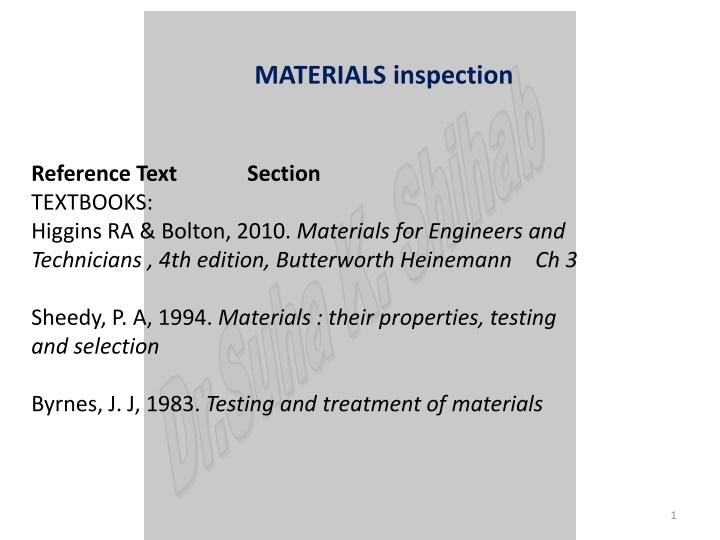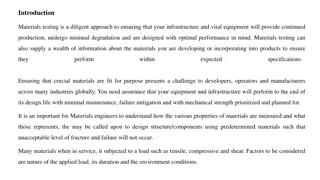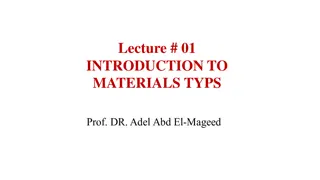
Materials Inspection, Testing, and Analysis in Engineering
Explore the importance of testing metals, types of tests (destructive and non-destructive), different forms of loading and stresses, various mechanical tests, and the benefits of non-destructive testing in material analysis for quality assurance and safety in engineering applications.
Download Presentation

Please find below an Image/Link to download the presentation.
The content on the website is provided AS IS for your information and personal use only. It may not be sold, licensed, or shared on other websites without obtaining consent from the author. If you encounter any issues during the download, it is possible that the publisher has removed the file from their server.
You are allowed to download the files provided on this website for personal or commercial use, subject to the condition that they are used lawfully. All files are the property of their respective owners.
The content on the website is provided AS IS for your information and personal use only. It may not be sold, licensed, or shared on other websites without obtaining consent from the author.
E N D
Presentation Transcript
MATERIALS inspection Reference Text TEXTBOOKS: Higgins RA & Bolton, 2010. Materials for Engineers and Technicians , 4th edition, Butterworth Heinemann Ch 3 Section Sheedy, P. A, 1994. Materials : their properties, testing and selection Byrnes, J. J, 1983. Testing and treatment of materials 1
MATERIALS TESTING Why are metals tested ? Ensure quality Test properties Prevent failure in use Make informed choices in using materials Factor of Safety is the ratio comparing the actual stress on a material and the safe useable stress. Factor of Safety describes the structural capacity of a system beyond the expected loads or actual loads (The safety factor is how much the designed part actually will be able to withstand ) Actual strength = factor of safety working safe stress 2
Two forms of tests Destructive tests (DT) is called mechanical tests. Itrequires destroying the specimen in order to measure the property. Often requires a specially prepared specimen. (e.g. Tensile test). Non-destructive tests (NDT): measures attributes of the specimen without damaging it. Does not normally need a prepared specimen. Typically used to find flaws inside a part. (e.g. X-ray, Ultrasound) . Tensile Test specimens Ultrasonic Weld Inspection: 3
Types of Loading Tensile Compressive Shear Torsion Bending 4
Types of stresses Compressive stress is the stress applied to materials resulting in their compaction (decrease of length). Usually compressive stress is applied to bars, columns, etc. Tensile stress is the stress state leading to expansion (length of a material tends to increase). In the uniaxial manner of tension, tensile stress is induced by pulling forces across a bar, specimen, etc. Shear stress: is a force that causes layers or parts to slide upon each other in opposite directions. Torsion the stress which resists a force tending to twist the material (e.g. axle, screw, etc.) Bending stress occurs when the force applied tends to pull a horizontal bar out of its straight line. 5
Destructive tests (DT) Tensile testing Compression testing Torsion testing Hardness testing Bending testing Impact testing Creep testing Fatigue testing Other mechanical tests 6
Why use NDT? Components are not destroyed Can test for internal flaws Useful for valuable components Can test components that are in use 7
Six Most Common NDT Methods Visual Testing Liquid Penetrant Testing Magnetic Particle Testing Eddy Current Ultrasonic Testing Radiography Testing (X-ray Inspection) 8
Material properties 1. Physical properties 2. Mechanical properties 3. Chemical properties Physical properties colour light wave length specific heat the heat required to raise the temperature of one gram of a substance by one degree centigrade (J/kg K) density mass per unit volume expressed in such units as kg/cm3 thermal conductivity rate at which heat flows through a given material (W/m K) melting point a temperature at which a solid begins to liquify electrical conductivity a measure of how strongly a material opposes the flow of electric current ( m) coefficient of thermal expansion degree of expansion divided by the change in temperature (m/ C) 9
Mechanical properties Tensile strength measures the force required to pull something such as rope,wire or a structural beam to the point where it breaks Malleability the property of a material that can be worked or hammered or shaped without breaking Ductility--ability to deform under tensile load without rupture; high percentage elongation and percent reduction of area indicate ductility brittleness breaking or shattering of a material when subjected to stress (when force is applied to it) Elasticity the property of a material that returns to its original shape after stress (e.g. external forces) that made it deform or distort is removed Plasticity - the deformation of a material undergoing non- reversible changes of shape in response to applied forces 10
Stiffness(Rigidity)--ability to resist deformation; proportional to Young s Modulus E (psi) E = stress/strain (slope of linear portion of stress/strain curve). Toughness the ability of a material to absorb energy and plastically deform without fracturing Hardness Hardness is closely related to strength. It is the ability of a material to resist scratching, abrasion, indentation, or penetration. Brittleness- The brittleness of a material is the property of breaking without much permanent distortion. There are many materials, which break or fail before much deformation take place. Such materials are brittle e.g., glass, cast iron. Machinability is the property of a material or a part to be machined, i.e., to remove material by cutting or abrasive processes, under given conditions 11
Mechanical properties Test Strength Tensile/ Compression/ Shear Stiffness Slope of Stress-vs-Strain curve Hardness Rockwell / Brinell / Vickers/ Micro hardness Toughness Impact: Charpy / Izod Chemical properties Corrosion resistance - a material's ability to resist deterioration caused by exposure to an environment Burning (Flammability): A material s ability to BURN in the presence of Oxygen 12
Which properties do the following materials possess? Material Properties Aluminium Lightness ; Strength Rubber Elasticity ; Insulation Ceramics Thermal Resistivity Steel Strength Copper Conductivity ; Corrosion Resistance Lead High Density; Ductility Nylon Strength ; Toughness Wood Insulation ; Environmental Friendliness 13
Find application for the following engineering materials: Material Application Aluminium Foil; Aircraft; Window Frame Rubber Tyres,; Seal; Gasket Ceramics Furnace; Brick Steel Section; Pipe Copper Pipe; Cables Lead Storage Battery; Radiation Protection Bullets Nylon Rope; Clothing Cast Iron Engine Block; Valves Wood Furniture; Deck 14






















